Critical Analysis: Comparing Intubation Devices in Child CPR
VerifiedAdded on 2021/04/24
|14
|4285
|56
Report
AI Summary
This report presents a critical analysis of a research paper by Szarpak et al. (2015) that compared the effectiveness of the McGrath MAC, GlideScope, AirTraq, and Miller laryngoscopes for intubation during paediatric cardiopulmonary resuscitation (CPR). The study, a randomized crossover manikin trial, aimed to evaluate the efficacy of these devices when used by paramedics. The analysis examines the study's rationale, search strategy, research rigor, and methodology, including sample size determination, blinding techniques, inclusion/exclusion criteria, and ethical considerations. The report discusses the study's strengths, such as its clear aim and the use of multiple statistical tests, while also noting potential limitations, such as the lack of complete participant blinding. Overall, the critical analysis assesses the study's contribution to the field of paediatric intubation and its implications for improving emergency airway management in children. The report highlights the importance of the study's findings in refining intubation procedures and reducing the risk of failure during paediatric CPR.
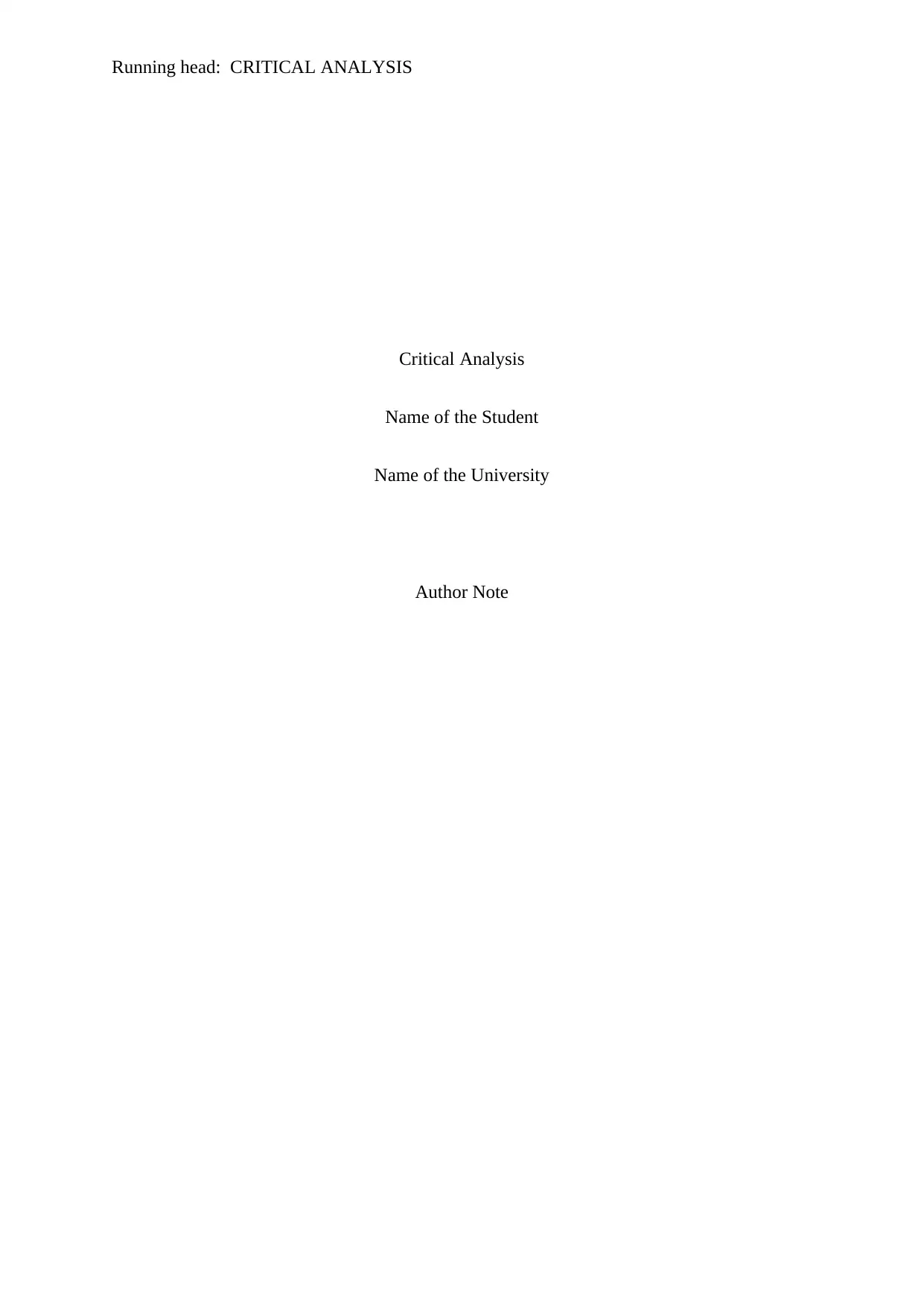
Running head: CRITICAL ANALYSIS
Critical Analysis
Name of the Student
Name of the University
Author Note
Critical Analysis
Name of the Student
Name of the University
Author Note
Paraphrase This Document
Need a fresh take? Get an instant paraphrase of this document with our AI Paraphraser
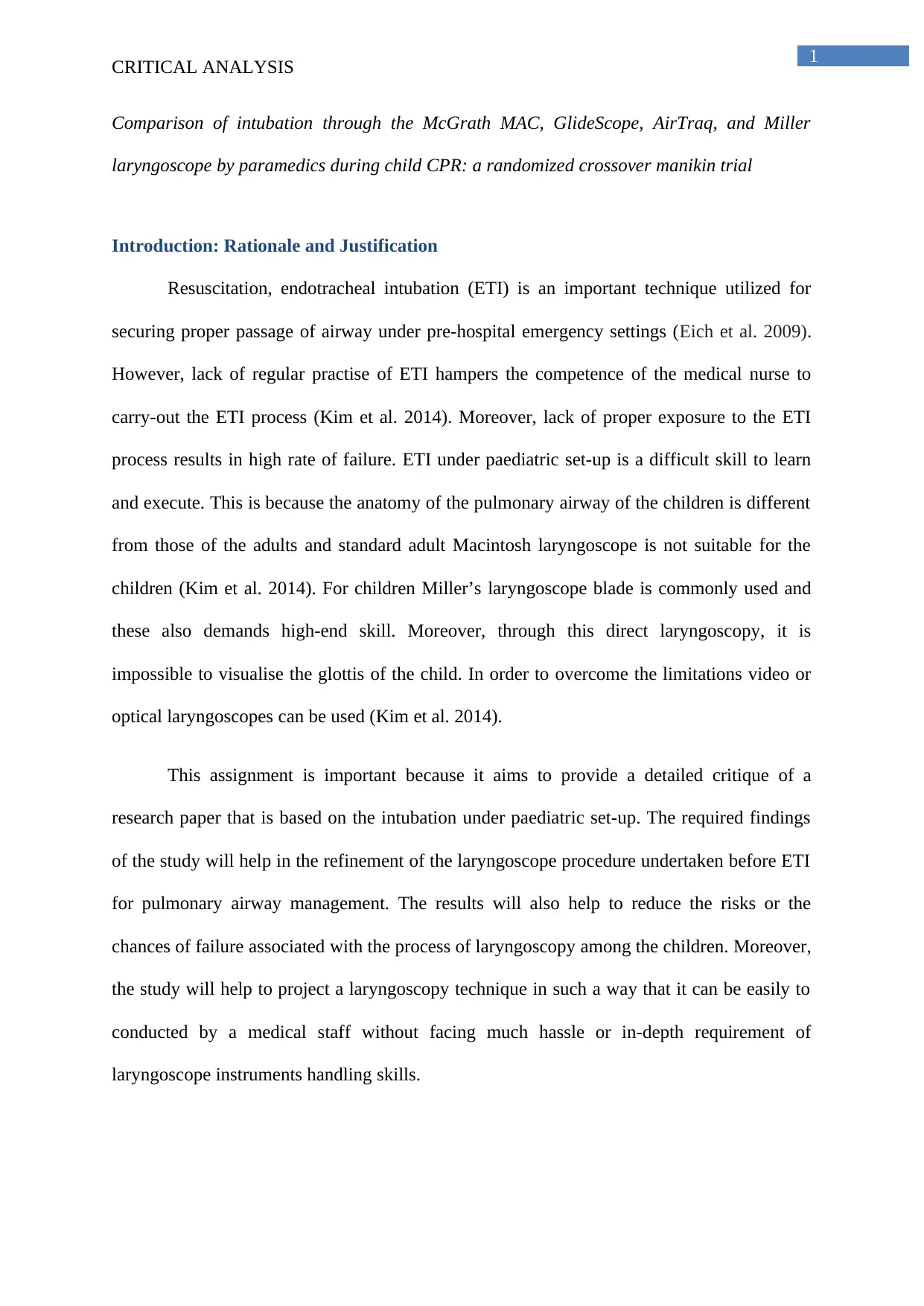
1
CRITICAL ANALYSIS
Comparison of intubation through the McGrath MAC, GlideScope, AirTraq, and Miller
laryngoscope by paramedics during child CPR: a randomized crossover manikin trial
Introduction: Rationale and Justification
Resuscitation, endotracheal intubation (ETI) is an important technique utilized for
securing proper passage of airway under pre-hospital emergency settings (Eich et al. 2009).
However, lack of regular practise of ETI hampers the competence of the medical nurse to
carry-out the ETI process (Kim et al. 2014). Moreover, lack of proper exposure to the ETI
process results in high rate of failure. ETI under paediatric set-up is a difficult skill to learn
and execute. This is because the anatomy of the pulmonary airway of the children is different
from those of the adults and standard adult Macintosh laryngoscope is not suitable for the
children (Kim et al. 2014). For children Miller’s laryngoscope blade is commonly used and
these also demands high-end skill. Moreover, through this direct laryngoscopy, it is
impossible to visualise the glottis of the child. In order to overcome the limitations video or
optical laryngoscopes can be used (Kim et al. 2014).
This assignment is important because it aims to provide a detailed critique of a
research paper that is based on the intubation under paediatric set-up. The required findings
of the study will help in the refinement of the laryngoscope procedure undertaken before ETI
for pulmonary airway management. The results will also help to reduce the risks or the
chances of failure associated with the process of laryngoscopy among the children. Moreover,
the study will help to project a laryngoscopy technique in such a way that it can be easily to
conducted by a medical staff without facing much hassle or in-depth requirement of
laryngoscope instruments handling skills.
CRITICAL ANALYSIS
Comparison of intubation through the McGrath MAC, GlideScope, AirTraq, and Miller
laryngoscope by paramedics during child CPR: a randomized crossover manikin trial
Introduction: Rationale and Justification
Resuscitation, endotracheal intubation (ETI) is an important technique utilized for
securing proper passage of airway under pre-hospital emergency settings (Eich et al. 2009).
However, lack of regular practise of ETI hampers the competence of the medical nurse to
carry-out the ETI process (Kim et al. 2014). Moreover, lack of proper exposure to the ETI
process results in high rate of failure. ETI under paediatric set-up is a difficult skill to learn
and execute. This is because the anatomy of the pulmonary airway of the children is different
from those of the adults and standard adult Macintosh laryngoscope is not suitable for the
children (Kim et al. 2014). For children Miller’s laryngoscope blade is commonly used and
these also demands high-end skill. Moreover, through this direct laryngoscopy, it is
impossible to visualise the glottis of the child. In order to overcome the limitations video or
optical laryngoscopes can be used (Kim et al. 2014).
This assignment is important because it aims to provide a detailed critique of a
research paper that is based on the intubation under paediatric set-up. The required findings
of the study will help in the refinement of the laryngoscope procedure undertaken before ETI
for pulmonary airway management. The results will also help to reduce the risks or the
chances of failure associated with the process of laryngoscopy among the children. Moreover,
the study will help to project a laryngoscopy technique in such a way that it can be easily to
conducted by a medical staff without facing much hassle or in-depth requirement of
laryngoscope instruments handling skills.
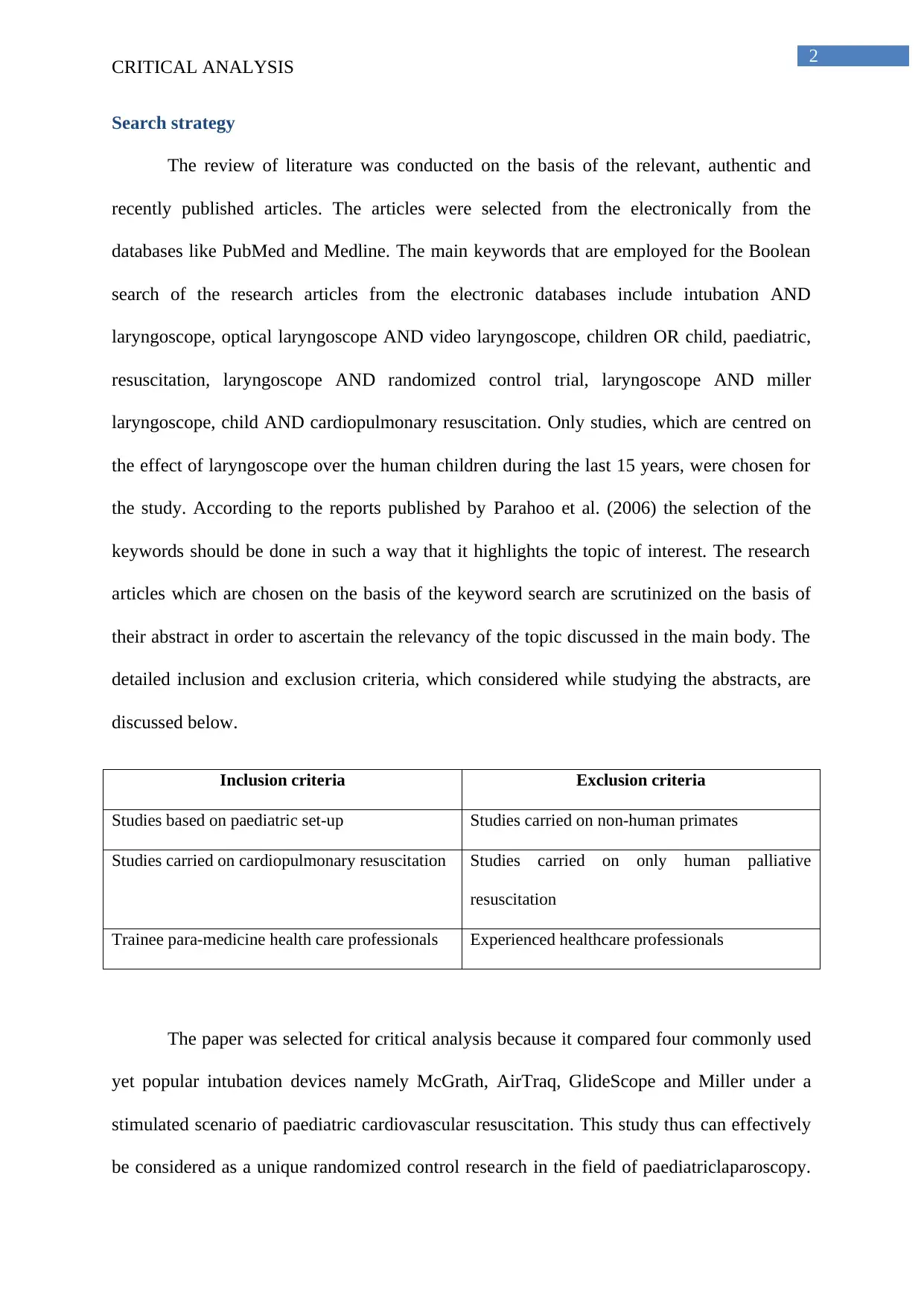
2
CRITICAL ANALYSIS
Search strategy
The review of literature was conducted on the basis of the relevant, authentic and
recently published articles. The articles were selected from the electronically from the
databases like PubMed and Medline. The main keywords that are employed for the Boolean
search of the research articles from the electronic databases include intubation AND
laryngoscope, optical laryngoscope AND video laryngoscope, children OR child, paediatric,
resuscitation, laryngoscope AND randomized control trial, laryngoscope AND miller
laryngoscope, child AND cardiopulmonary resuscitation. Only studies, which are centred on
the effect of laryngoscope over the human children during the last 15 years, were chosen for
the study. According to the reports published by Parahoo et al. (2006) the selection of the
keywords should be done in such a way that it highlights the topic of interest. The research
articles which are chosen on the basis of the keyword search are scrutinized on the basis of
their abstract in order to ascertain the relevancy of the topic discussed in the main body. The
detailed inclusion and exclusion criteria, which considered while studying the abstracts, are
discussed below.
Inclusion criteria Exclusion criteria
Studies based on paediatric set-up Studies carried on non-human primates
Studies carried on cardiopulmonary resuscitation Studies carried on only human palliative
resuscitation
Trainee para-medicine health care professionals Experienced healthcare professionals
The paper was selected for critical analysis because it compared four commonly used
yet popular intubation devices namely McGrath, AirTraq, GlideScope and Miller under a
stimulated scenario of paediatric cardiovascular resuscitation. This study thus can effectively
be considered as a unique randomized control research in the field of paediatriclaparoscopy.
CRITICAL ANALYSIS
Search strategy
The review of literature was conducted on the basis of the relevant, authentic and
recently published articles. The articles were selected from the electronically from the
databases like PubMed and Medline. The main keywords that are employed for the Boolean
search of the research articles from the electronic databases include intubation AND
laryngoscope, optical laryngoscope AND video laryngoscope, children OR child, paediatric,
resuscitation, laryngoscope AND randomized control trial, laryngoscope AND miller
laryngoscope, child AND cardiopulmonary resuscitation. Only studies, which are centred on
the effect of laryngoscope over the human children during the last 15 years, were chosen for
the study. According to the reports published by Parahoo et al. (2006) the selection of the
keywords should be done in such a way that it highlights the topic of interest. The research
articles which are chosen on the basis of the keyword search are scrutinized on the basis of
their abstract in order to ascertain the relevancy of the topic discussed in the main body. The
detailed inclusion and exclusion criteria, which considered while studying the abstracts, are
discussed below.
Inclusion criteria Exclusion criteria
Studies based on paediatric set-up Studies carried on non-human primates
Studies carried on cardiopulmonary resuscitation Studies carried on only human palliative
resuscitation
Trainee para-medicine health care professionals Experienced healthcare professionals
The paper was selected for critical analysis because it compared four commonly used
yet popular intubation devices namely McGrath, AirTraq, GlideScope and Miller under a
stimulated scenario of paediatric cardiovascular resuscitation. This study thus can effectively
be considered as a unique randomized control research in the field of paediatriclaparoscopy.
⊘ This is a preview!⊘
Do you want full access?
Subscribe today to unlock all pages.

Trusted by 1+ million students worldwide
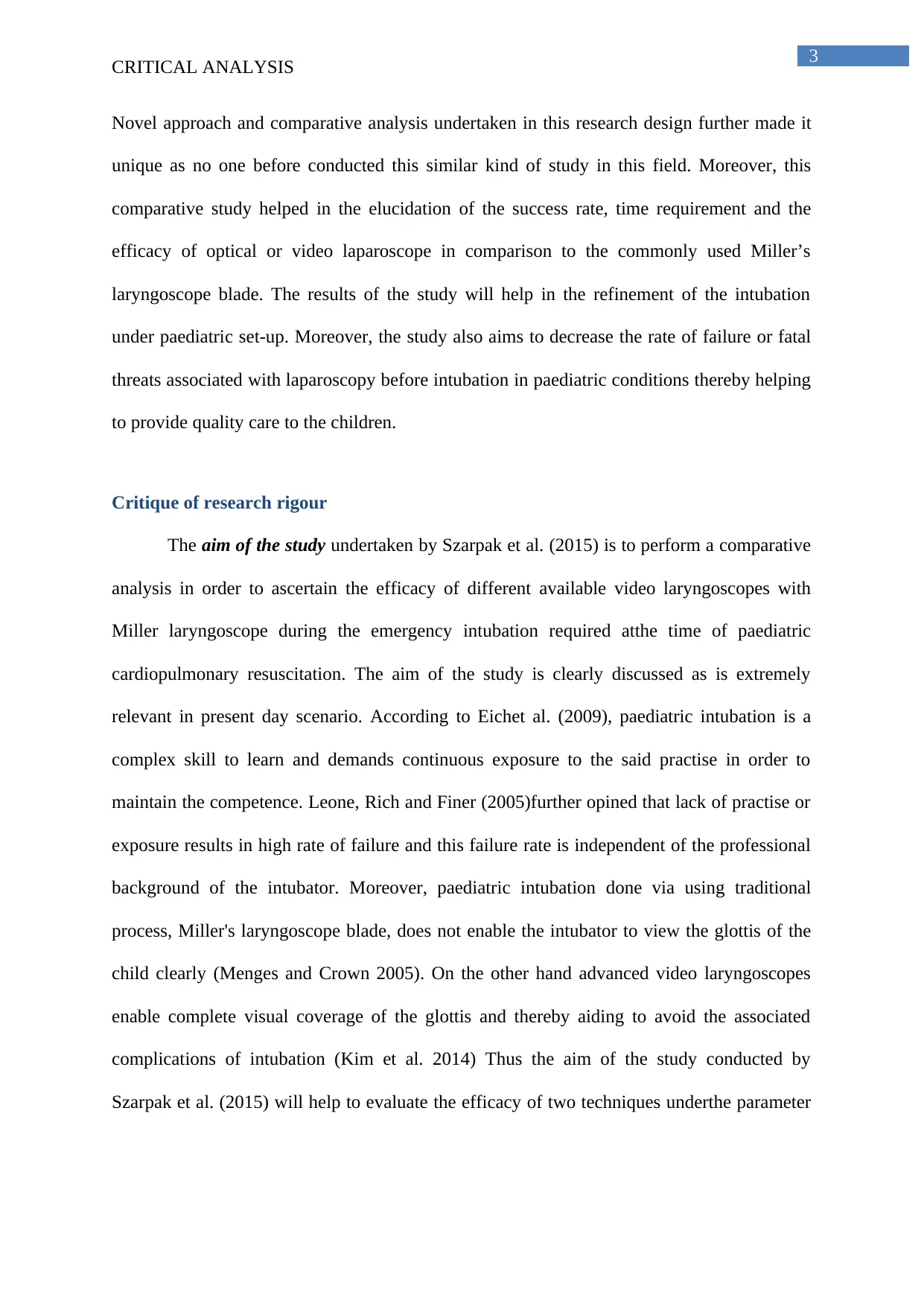
3
CRITICAL ANALYSIS
Novel approach and comparative analysis undertaken in this research design further made it
unique as no one before conducted this similar kind of study in this field. Moreover, this
comparative study helped in the elucidation of the success rate, time requirement and the
efficacy of optical or video laparoscope in comparison to the commonly used Miller’s
laryngoscope blade. The results of the study will help in the refinement of the intubation
under paediatric set-up. Moreover, the study also aims to decrease the rate of failure or fatal
threats associated with laparoscopy before intubation in paediatric conditions thereby helping
to provide quality care to the children.
Critique of research rigour
The aim of the study undertaken by Szarpak et al. (2015) is to perform a comparative
analysis in order to ascertain the efficacy of different available video laryngoscopes with
Miller laryngoscope during the emergency intubation required atthe time of paediatric
cardiopulmonary resuscitation. The aim of the study is clearly discussed as is extremely
relevant in present day scenario. According to Eichet al. (2009), paediatric intubation is a
complex skill to learn and demands continuous exposure to the said practise in order to
maintain the competence. Leone, Rich and Finer (2005)further opined that lack of practise or
exposure results in high rate of failure and this failure rate is independent of the professional
background of the intubator. Moreover, paediatric intubation done via using traditional
process, Miller's laryngoscope blade, does not enable the intubator to view the glottis of the
child clearly (Menges and Crown 2005). On the other hand advanced video laryngoscopes
enable complete visual coverage of the glottis and thereby aiding to avoid the associated
complications of intubation (Kim et al. 2014) Thus the aim of the study conducted by
Szarpak et al. (2015) will help to evaluate the efficacy of two techniques underthe parameter
CRITICAL ANALYSIS
Novel approach and comparative analysis undertaken in this research design further made it
unique as no one before conducted this similar kind of study in this field. Moreover, this
comparative study helped in the elucidation of the success rate, time requirement and the
efficacy of optical or video laparoscope in comparison to the commonly used Miller’s
laryngoscope blade. The results of the study will help in the refinement of the intubation
under paediatric set-up. Moreover, the study also aims to decrease the rate of failure or fatal
threats associated with laparoscopy before intubation in paediatric conditions thereby helping
to provide quality care to the children.
Critique of research rigour
The aim of the study undertaken by Szarpak et al. (2015) is to perform a comparative
analysis in order to ascertain the efficacy of different available video laryngoscopes with
Miller laryngoscope during the emergency intubation required atthe time of paediatric
cardiopulmonary resuscitation. The aim of the study is clearly discussed as is extremely
relevant in present day scenario. According to Eichet al. (2009), paediatric intubation is a
complex skill to learn and demands continuous exposure to the said practise in order to
maintain the competence. Leone, Rich and Finer (2005)further opined that lack of practise or
exposure results in high rate of failure and this failure rate is independent of the professional
background of the intubator. Moreover, paediatric intubation done via using traditional
process, Miller's laryngoscope blade, does not enable the intubator to view the glottis of the
child clearly (Menges and Crown 2005). On the other hand advanced video laryngoscopes
enable complete visual coverage of the glottis and thereby aiding to avoid the associated
complications of intubation (Kim et al. 2014) Thus the aim of the study conducted by
Szarpak et al. (2015) will help to evaluate the efficacy of two techniques underthe parameter
Paraphrase This Document
Need a fresh take? Get an instant paraphrase of this document with our AI Paraphraser
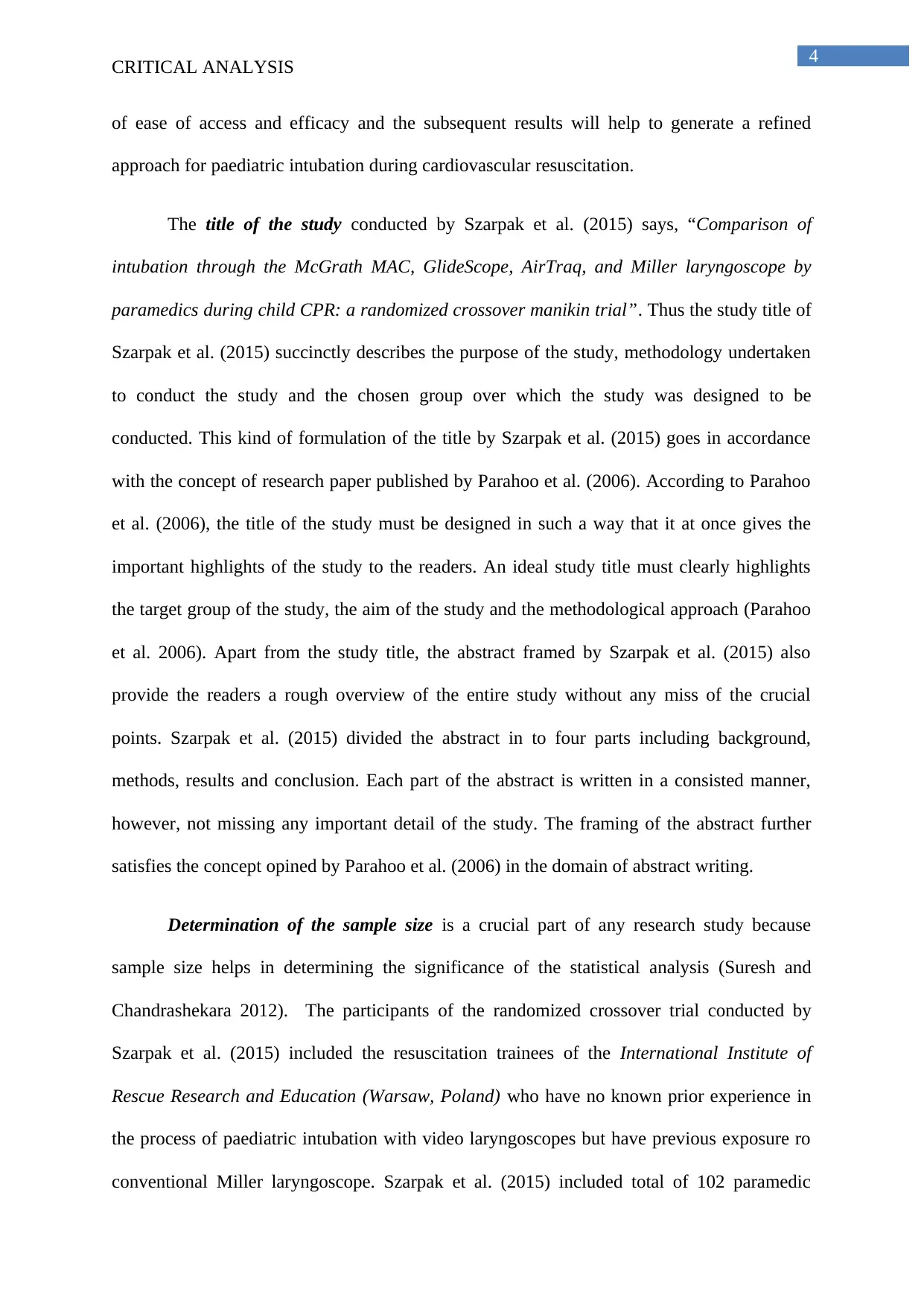
4
CRITICAL ANALYSIS
of ease of access and efficacy and the subsequent results will help to generate a refined
approach for paediatric intubation during cardiovascular resuscitation.
The title of the study conducted by Szarpak et al. (2015) says, “Comparison of
intubation through the McGrath MAC, GlideScope, AirTraq, and Miller laryngoscope by
paramedics during child CPR: a randomized crossover manikin trial”. Thus the study title of
Szarpak et al. (2015) succinctly describes the purpose of the study, methodology undertaken
to conduct the study and the chosen group over which the study was designed to be
conducted. This kind of formulation of the title by Szarpak et al. (2015) goes in accordance
with the concept of research paper published by Parahoo et al. (2006). According to Parahoo
et al. (2006), the title of the study must be designed in such a way that it at once gives the
important highlights of the study to the readers. An ideal study title must clearly highlights
the target group of the study, the aim of the study and the methodological approach (Parahoo
et al. 2006). Apart from the study title, the abstract framed by Szarpak et al. (2015) also
provide the readers a rough overview of the entire study without any miss of the crucial
points. Szarpak et al. (2015) divided the abstract in to four parts including background,
methods, results and conclusion. Each part of the abstract is written in a consisted manner,
however, not missing any important detail of the study. The framing of the abstract further
satisfies the concept opined by Parahoo et al. (2006) in the domain of abstract writing.
Determination of the sample size is a crucial part of any research study because
sample size helps in determining the significance of the statistical analysis (Suresh and
Chandrashekara 2012). The participants of the randomized crossover trial conducted by
Szarpak et al. (2015) included the resuscitation trainees of the International Institute of
Rescue Research and Education (Warsaw, Poland) who have no known prior experience in
the process of paediatric intubation with video laryngoscopes but have previous exposure ro
conventional Miller laryngoscope. Szarpak et al. (2015) included total of 102 paramedic
CRITICAL ANALYSIS
of ease of access and efficacy and the subsequent results will help to generate a refined
approach for paediatric intubation during cardiovascular resuscitation.
The title of the study conducted by Szarpak et al. (2015) says, “Comparison of
intubation through the McGrath MAC, GlideScope, AirTraq, and Miller laryngoscope by
paramedics during child CPR: a randomized crossover manikin trial”. Thus the study title of
Szarpak et al. (2015) succinctly describes the purpose of the study, methodology undertaken
to conduct the study and the chosen group over which the study was designed to be
conducted. This kind of formulation of the title by Szarpak et al. (2015) goes in accordance
with the concept of research paper published by Parahoo et al. (2006). According to Parahoo
et al. (2006), the title of the study must be designed in such a way that it at once gives the
important highlights of the study to the readers. An ideal study title must clearly highlights
the target group of the study, the aim of the study and the methodological approach (Parahoo
et al. 2006). Apart from the study title, the abstract framed by Szarpak et al. (2015) also
provide the readers a rough overview of the entire study without any miss of the crucial
points. Szarpak et al. (2015) divided the abstract in to four parts including background,
methods, results and conclusion. Each part of the abstract is written in a consisted manner,
however, not missing any important detail of the study. The framing of the abstract further
satisfies the concept opined by Parahoo et al. (2006) in the domain of abstract writing.
Determination of the sample size is a crucial part of any research study because
sample size helps in determining the significance of the statistical analysis (Suresh and
Chandrashekara 2012). The participants of the randomized crossover trial conducted by
Szarpak et al. (2015) included the resuscitation trainees of the International Institute of
Rescue Research and Education (Warsaw, Poland) who have no known prior experience in
the process of paediatric intubation with video laryngoscopes but have previous exposure ro
conventional Miller laryngoscope. Szarpak et al. (2015) included total of 102 paramedic
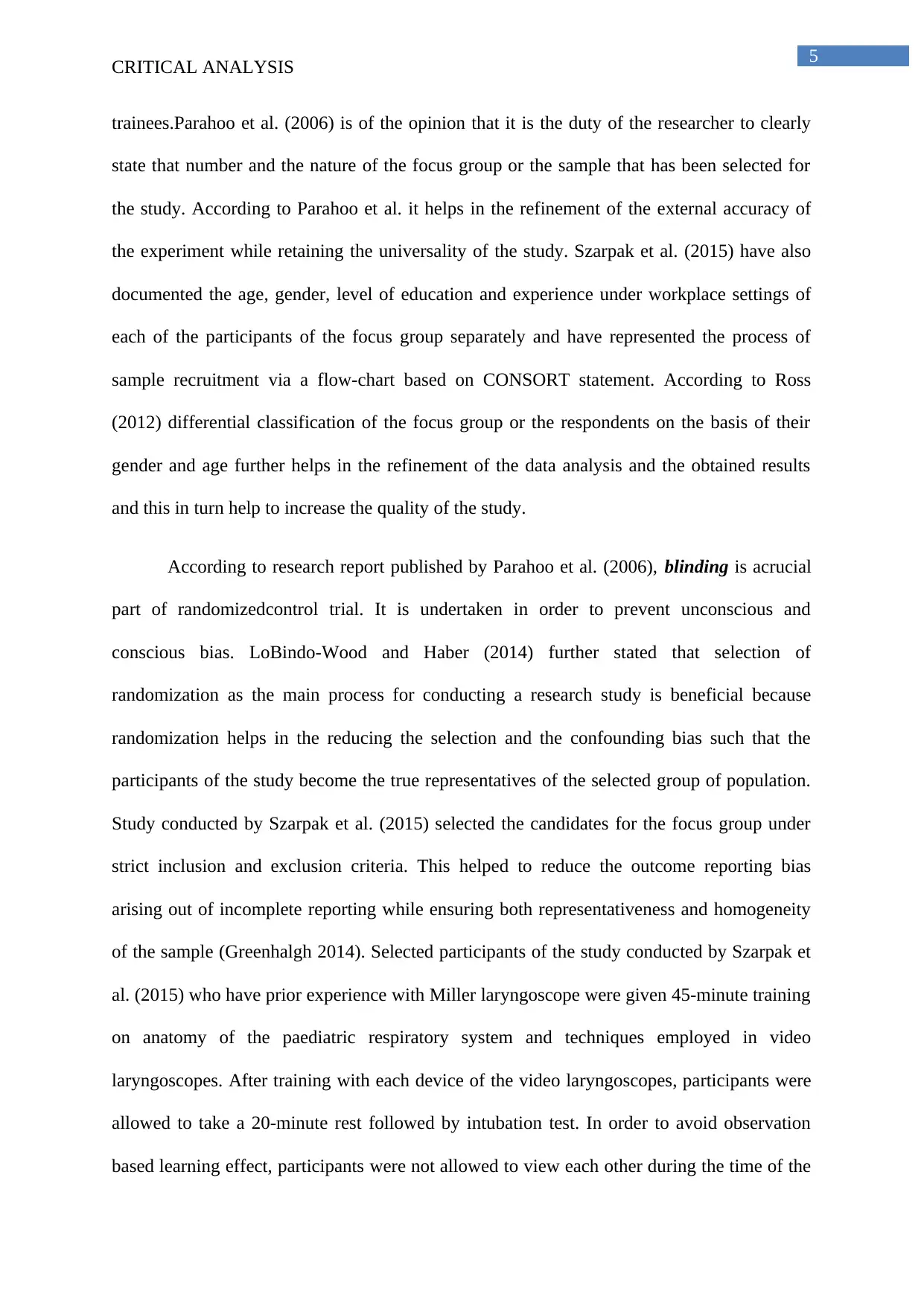
5
CRITICAL ANALYSIS
trainees.Parahoo et al. (2006) is of the opinion that it is the duty of the researcher to clearly
state that number and the nature of the focus group or the sample that has been selected for
the study. According to Parahoo et al. it helps in the refinement of the external accuracy of
the experiment while retaining the universality of the study. Szarpak et al. (2015) have also
documented the age, gender, level of education and experience under workplace settings of
each of the participants of the focus group separately and have represented the process of
sample recruitment via a flow-chart based on CONSORT statement. According to Ross
(2012) differential classification of the focus group or the respondents on the basis of their
gender and age further helps in the refinement of the data analysis and the obtained results
and this in turn help to increase the quality of the study.
According to research report published by Parahoo et al. (2006), blinding is acrucial
part of randomizedcontrol trial. It is undertaken in order to prevent unconscious and
conscious bias. LoBindo-Wood and Haber (2014) further stated that selection of
randomization as the main process for conducting a research study is beneficial because
randomization helps in the reducing the selection and the confounding bias such that the
participants of the study become the true representatives of the selected group of population.
Study conducted by Szarpak et al. (2015) selected the candidates for the focus group under
strict inclusion and exclusion criteria. This helped to reduce the outcome reporting bias
arising out of incomplete reporting while ensuring both representativeness and homogeneity
of the sample (Greenhalgh 2014). Selected participants of the study conducted by Szarpak et
al. (2015) who have prior experience with Miller laryngoscope were given 45-minute training
on anatomy of the paediatric respiratory system and techniques employed in video
laryngoscopes. After training with each device of the video laryngoscopes, participants were
allowed to take a 20-minute rest followed by intubation test. In order to avoid observation
based learning effect, participants were not allowed to view each other during the time of the
CRITICAL ANALYSIS
trainees.Parahoo et al. (2006) is of the opinion that it is the duty of the researcher to clearly
state that number and the nature of the focus group or the sample that has been selected for
the study. According to Parahoo et al. it helps in the refinement of the external accuracy of
the experiment while retaining the universality of the study. Szarpak et al. (2015) have also
documented the age, gender, level of education and experience under workplace settings of
each of the participants of the focus group separately and have represented the process of
sample recruitment via a flow-chart based on CONSORT statement. According to Ross
(2012) differential classification of the focus group or the respondents on the basis of their
gender and age further helps in the refinement of the data analysis and the obtained results
and this in turn help to increase the quality of the study.
According to research report published by Parahoo et al. (2006), blinding is acrucial
part of randomizedcontrol trial. It is undertaken in order to prevent unconscious and
conscious bias. LoBindo-Wood and Haber (2014) further stated that selection of
randomization as the main process for conducting a research study is beneficial because
randomization helps in the reducing the selection and the confounding bias such that the
participants of the study become the true representatives of the selected group of population.
Study conducted by Szarpak et al. (2015) selected the candidates for the focus group under
strict inclusion and exclusion criteria. This helped to reduce the outcome reporting bias
arising out of incomplete reporting while ensuring both representativeness and homogeneity
of the sample (Greenhalgh 2014). Selected participants of the study conducted by Szarpak et
al. (2015) who have prior experience with Miller laryngoscope were given 45-minute training
on anatomy of the paediatric respiratory system and techniques employed in video
laryngoscopes. After training with each device of the video laryngoscopes, participants were
allowed to take a 20-minute rest followed by intubation test. In order to avoid observation
based learning effect, participants were not allowed to view each other during the time of the
⊘ This is a preview!⊘
Do you want full access?
Subscribe today to unlock all pages.

Trusted by 1+ million students worldwide
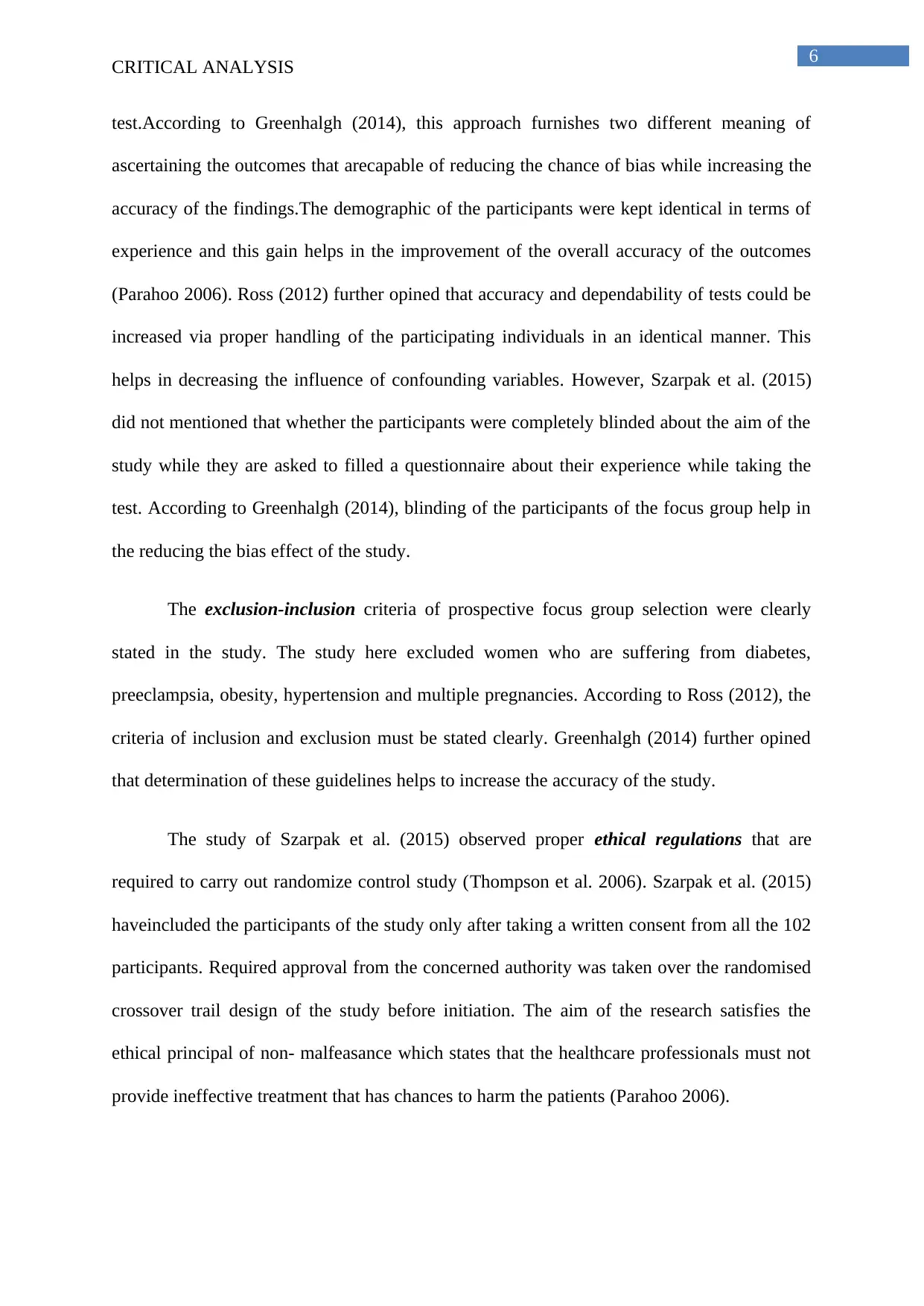
6
CRITICAL ANALYSIS
test.According to Greenhalgh (2014), this approach furnishes two different meaning of
ascertaining the outcomes that arecapable of reducing the chance of bias while increasing the
accuracy of the findings.The demographic of the participants were kept identical in terms of
experience and this gain helps in the improvement of the overall accuracy of the outcomes
(Parahoo 2006). Ross (2012) further opined that accuracy and dependability of tests could be
increased via proper handling of the participating individuals in an identical manner. This
helps in decreasing the influence of confounding variables. However, Szarpak et al. (2015)
did not mentioned that whether the participants were completely blinded about the aim of the
study while they are asked to filled a questionnaire about their experience while taking the
test. According to Greenhalgh (2014), blinding of the participants of the focus group help in
the reducing the bias effect of the study.
The exclusion-inclusion criteria of prospective focus group selection were clearly
stated in the study. The study here excluded women who are suffering from diabetes,
preeclampsia, obesity, hypertension and multiple pregnancies. According to Ross (2012), the
criteria of inclusion and exclusion must be stated clearly. Greenhalgh (2014) further opined
that determination of these guidelines helps to increase the accuracy of the study.
The study of Szarpak et al. (2015) observed proper ethical regulations that are
required to carry out randomize control study (Thompson et al. 2006). Szarpak et al. (2015)
haveincluded the participants of the study only after taking a written consent from all the 102
participants. Required approval from the concerned authority was taken over the randomised
crossover trail design of the study before initiation. The aim of the research satisfies the
ethical principal of non- malfeasance which states that the healthcare professionals must not
provide ineffective treatment that has chances to harm the patients (Parahoo 2006).
CRITICAL ANALYSIS
test.According to Greenhalgh (2014), this approach furnishes two different meaning of
ascertaining the outcomes that arecapable of reducing the chance of bias while increasing the
accuracy of the findings.The demographic of the participants were kept identical in terms of
experience and this gain helps in the improvement of the overall accuracy of the outcomes
(Parahoo 2006). Ross (2012) further opined that accuracy and dependability of tests could be
increased via proper handling of the participating individuals in an identical manner. This
helps in decreasing the influence of confounding variables. However, Szarpak et al. (2015)
did not mentioned that whether the participants were completely blinded about the aim of the
study while they are asked to filled a questionnaire about their experience while taking the
test. According to Greenhalgh (2014), blinding of the participants of the focus group help in
the reducing the bias effect of the study.
The exclusion-inclusion criteria of prospective focus group selection were clearly
stated in the study. The study here excluded women who are suffering from diabetes,
preeclampsia, obesity, hypertension and multiple pregnancies. According to Ross (2012), the
criteria of inclusion and exclusion must be stated clearly. Greenhalgh (2014) further opined
that determination of these guidelines helps to increase the accuracy of the study.
The study of Szarpak et al. (2015) observed proper ethical regulations that are
required to carry out randomize control study (Thompson et al. 2006). Szarpak et al. (2015)
haveincluded the participants of the study only after taking a written consent from all the 102
participants. Required approval from the concerned authority was taken over the randomised
crossover trail design of the study before initiation. The aim of the research satisfies the
ethical principal of non- malfeasance which states that the healthcare professionals must not
provide ineffective treatment that has chances to harm the patients (Parahoo 2006).
Paraphrase This Document
Need a fresh take? Get an instant paraphrase of this document with our AI Paraphraser
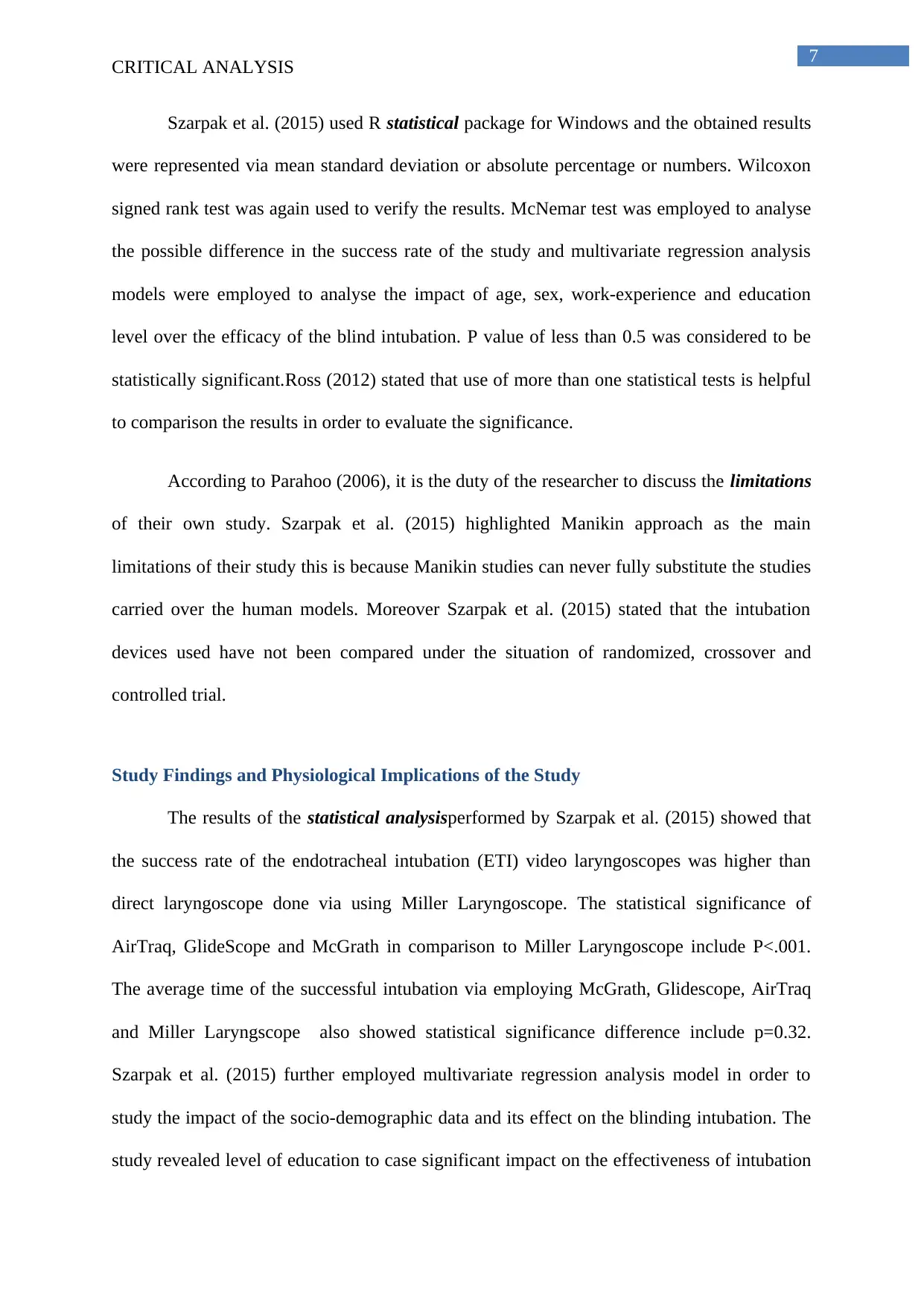
7
CRITICAL ANALYSIS
Szarpak et al. (2015) used R statistical package for Windows and the obtained results
were represented via mean standard deviation or absolute percentage or numbers. Wilcoxon
signed rank test was again used to verify the results. McNemar test was employed to analyse
the possible difference in the success rate of the study and multivariate regression analysis
models were employed to analyse the impact of age, sex, work-experience and education
level over the efficacy of the blind intubation. P value of less than 0.5 was considered to be
statistically significant.Ross (2012) stated that use of more than one statistical tests is helpful
to comparison the results in order to evaluate the significance.
According to Parahoo (2006), it is the duty of the researcher to discuss the limitations
of their own study. Szarpak et al. (2015) highlighted Manikin approach as the main
limitations of their study this is because Manikin studies can never fully substitute the studies
carried over the human models. Moreover Szarpak et al. (2015) stated that the intubation
devices used have not been compared under the situation of randomized, crossover and
controlled trial.
Study Findings and Physiological Implications of the Study
The results of the statistical analysisperformed by Szarpak et al. (2015) showed that
the success rate of the endotracheal intubation (ETI) video laryngoscopes was higher than
direct laryngoscope done via using Miller Laryngoscope. The statistical significance of
AirTraq, GlideScope and McGrath in comparison to Miller Laryngoscope include P<.001.
The average time of the successful intubation via employing McGrath, Glidescope, AirTraq
and Miller Laryngscope also showed statistical significance difference include p=0.32.
Szarpak et al. (2015) further employed multivariate regression analysis model in order to
study the impact of the socio-demographic data and its effect on the blinding intubation. The
study revealed level of education to case significant impact on the effectiveness of intubation
CRITICAL ANALYSIS
Szarpak et al. (2015) used R statistical package for Windows and the obtained results
were represented via mean standard deviation or absolute percentage or numbers. Wilcoxon
signed rank test was again used to verify the results. McNemar test was employed to analyse
the possible difference in the success rate of the study and multivariate regression analysis
models were employed to analyse the impact of age, sex, work-experience and education
level over the efficacy of the blind intubation. P value of less than 0.5 was considered to be
statistically significant.Ross (2012) stated that use of more than one statistical tests is helpful
to comparison the results in order to evaluate the significance.
According to Parahoo (2006), it is the duty of the researcher to discuss the limitations
of their own study. Szarpak et al. (2015) highlighted Manikin approach as the main
limitations of their study this is because Manikin studies can never fully substitute the studies
carried over the human models. Moreover Szarpak et al. (2015) stated that the intubation
devices used have not been compared under the situation of randomized, crossover and
controlled trial.
Study Findings and Physiological Implications of the Study
The results of the statistical analysisperformed by Szarpak et al. (2015) showed that
the success rate of the endotracheal intubation (ETI) video laryngoscopes was higher than
direct laryngoscope done via using Miller Laryngoscope. The statistical significance of
AirTraq, GlideScope and McGrath in comparison to Miller Laryngoscope include P<.001.
The average time of the successful intubation via employing McGrath, Glidescope, AirTraq
and Miller Laryngscope also showed statistical significance difference include p=0.32.
Szarpak et al. (2015) further employed multivariate regression analysis model in order to
study the impact of the socio-demographic data and its effect on the blinding intubation. The
study revealed level of education to case significant impact on the effectiveness of intubation
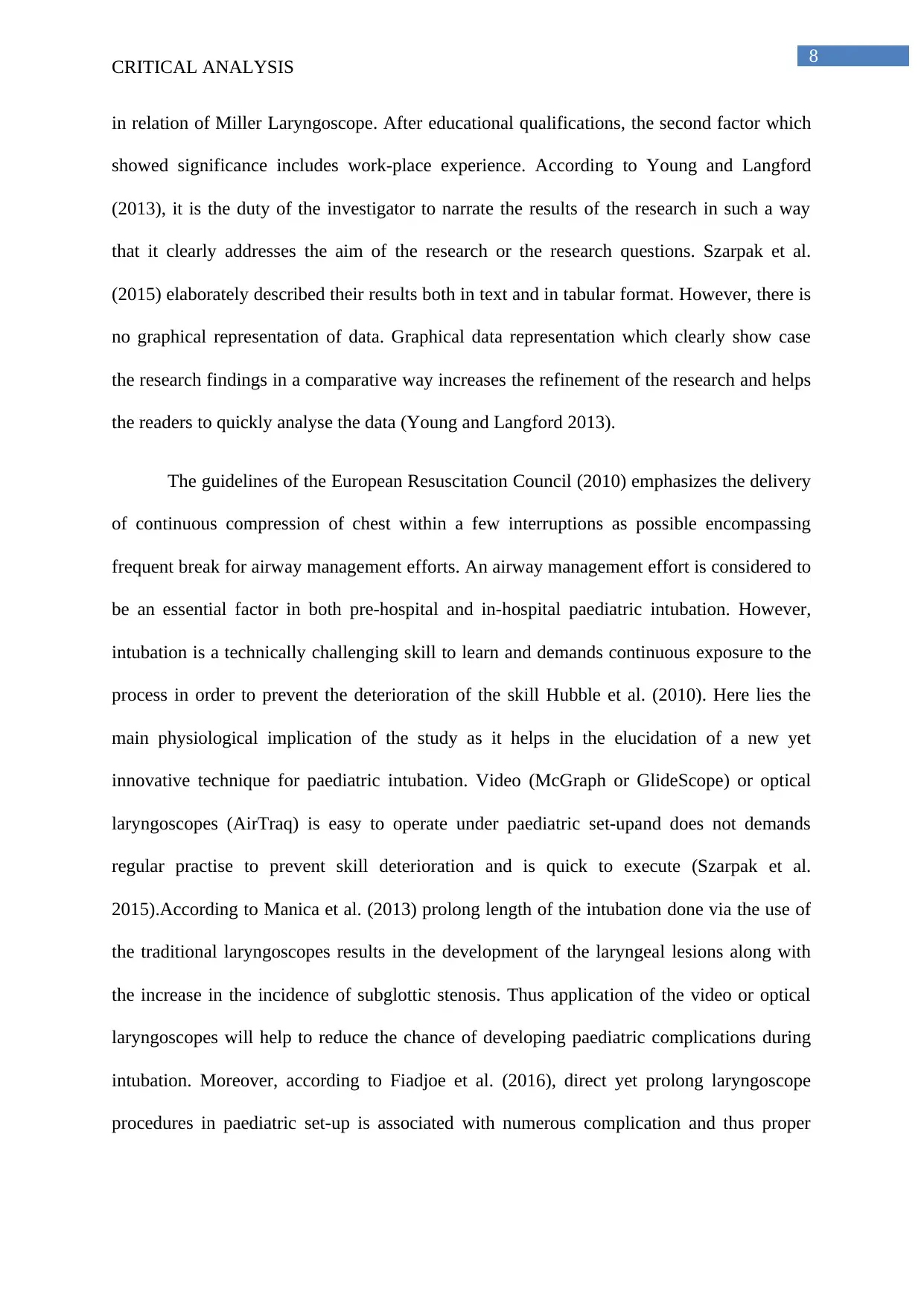
8
CRITICAL ANALYSIS
in relation of Miller Laryngoscope. After educational qualifications, the second factor which
showed significance includes work-place experience. According to Young and Langford
(2013), it is the duty of the investigator to narrate the results of the research in such a way
that it clearly addresses the aim of the research or the research questions. Szarpak et al.
(2015) elaborately described their results both in text and in tabular format. However, there is
no graphical representation of data. Graphical data representation which clearly show case
the research findings in a comparative way increases the refinement of the research and helps
the readers to quickly analyse the data (Young and Langford 2013).
The guidelines of the European Resuscitation Council (2010) emphasizes the delivery
of continuous compression of chest within a few interruptions as possible encompassing
frequent break for airway management efforts. An airway management effort is considered to
be an essential factor in both pre-hospital and in-hospital paediatric intubation. However,
intubation is a technically challenging skill to learn and demands continuous exposure to the
process in order to prevent the deterioration of the skill Hubble et al. (2010). Here lies the
main physiological implication of the study as it helps in the elucidation of a new yet
innovative technique for paediatric intubation. Video (McGraph or GlideScope) or optical
laryngoscopes (AirTraq) is easy to operate under paediatric set-upand does not demands
regular practise to prevent skill deterioration and is quick to execute (Szarpak et al.
2015).According to Manica et al. (2013) prolong length of the intubation done via the use of
the traditional laryngoscopes results in the development of the laryngeal lesions along with
the increase in the incidence of subglottic stenosis. Thus application of the video or optical
laryngoscopes will help to reduce the chance of developing paediatric complications during
intubation. Moreover, according to Fiadjoe et al. (2016), direct yet prolong laryngoscope
procedures in paediatric set-up is associated with numerous complication and thus proper
CRITICAL ANALYSIS
in relation of Miller Laryngoscope. After educational qualifications, the second factor which
showed significance includes work-place experience. According to Young and Langford
(2013), it is the duty of the investigator to narrate the results of the research in such a way
that it clearly addresses the aim of the research or the research questions. Szarpak et al.
(2015) elaborately described their results both in text and in tabular format. However, there is
no graphical representation of data. Graphical data representation which clearly show case
the research findings in a comparative way increases the refinement of the research and helps
the readers to quickly analyse the data (Young and Langford 2013).
The guidelines of the European Resuscitation Council (2010) emphasizes the delivery
of continuous compression of chest within a few interruptions as possible encompassing
frequent break for airway management efforts. An airway management effort is considered to
be an essential factor in both pre-hospital and in-hospital paediatric intubation. However,
intubation is a technically challenging skill to learn and demands continuous exposure to the
process in order to prevent the deterioration of the skill Hubble et al. (2010). Here lies the
main physiological implication of the study as it helps in the elucidation of a new yet
innovative technique for paediatric intubation. Video (McGraph or GlideScope) or optical
laryngoscopes (AirTraq) is easy to operate under paediatric set-upand does not demands
regular practise to prevent skill deterioration and is quick to execute (Szarpak et al.
2015).According to Manica et al. (2013) prolong length of the intubation done via the use of
the traditional laryngoscopes results in the development of the laryngeal lesions along with
the increase in the incidence of subglottic stenosis. Thus application of the video or optical
laryngoscopes will help to reduce the chance of developing paediatric complications during
intubation. Moreover, according to Fiadjoe et al. (2016), direct yet prolong laryngoscope
procedures in paediatric set-up is associated with numerous complication and thus proper
⊘ This is a preview!⊘
Do you want full access?
Subscribe today to unlock all pages.

Trusted by 1+ million students worldwide
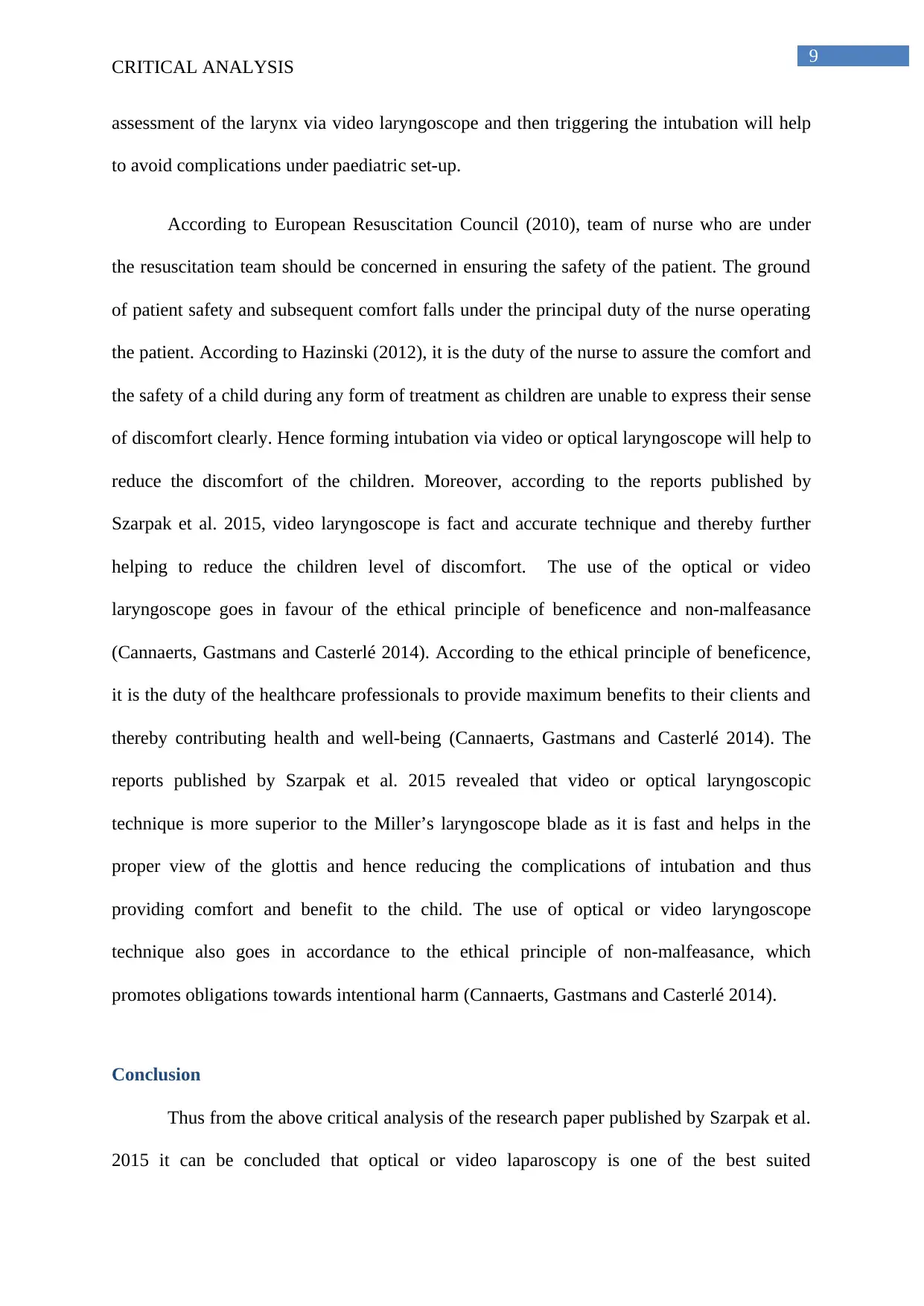
9
CRITICAL ANALYSIS
assessment of the larynx via video laryngoscope and then triggering the intubation will help
to avoid complications under paediatric set-up.
According to European Resuscitation Council (2010), team of nurse who are under
the resuscitation team should be concerned in ensuring the safety of the patient. The ground
of patient safety and subsequent comfort falls under the principal duty of the nurse operating
the patient. According to Hazinski (2012), it is the duty of the nurse to assure the comfort and
the safety of a child during any form of treatment as children are unable to express their sense
of discomfort clearly. Hence forming intubation via video or optical laryngoscope will help to
reduce the discomfort of the children. Moreover, according to the reports published by
Szarpak et al. 2015, video laryngoscope is fact and accurate technique and thereby further
helping to reduce the children level of discomfort. The use of the optical or video
laryngoscope goes in favour of the ethical principle of beneficence and non-malfeasance
(Cannaerts, Gastmans and Casterlé 2014). According to the ethical principle of beneficence,
it is the duty of the healthcare professionals to provide maximum benefits to their clients and
thereby contributing health and well-being (Cannaerts, Gastmans and Casterlé 2014). The
reports published by Szarpak et al. 2015 revealed that video or optical laryngoscopic
technique is more superior to the Miller’s laryngoscope blade as it is fast and helps in the
proper view of the glottis and hence reducing the complications of intubation and thus
providing comfort and benefit to the child. The use of optical or video laryngoscope
technique also goes in accordance to the ethical principle of non-malfeasance, which
promotes obligations towards intentional harm (Cannaerts, Gastmans and Casterlé 2014).
Conclusion
Thus from the above critical analysis of the research paper published by Szarpak et al.
2015 it can be concluded that optical or video laparoscopy is one of the best suited
CRITICAL ANALYSIS
assessment of the larynx via video laryngoscope and then triggering the intubation will help
to avoid complications under paediatric set-up.
According to European Resuscitation Council (2010), team of nurse who are under
the resuscitation team should be concerned in ensuring the safety of the patient. The ground
of patient safety and subsequent comfort falls under the principal duty of the nurse operating
the patient. According to Hazinski (2012), it is the duty of the nurse to assure the comfort and
the safety of a child during any form of treatment as children are unable to express their sense
of discomfort clearly. Hence forming intubation via video or optical laryngoscope will help to
reduce the discomfort of the children. Moreover, according to the reports published by
Szarpak et al. 2015, video laryngoscope is fact and accurate technique and thereby further
helping to reduce the children level of discomfort. The use of the optical or video
laryngoscope goes in favour of the ethical principle of beneficence and non-malfeasance
(Cannaerts, Gastmans and Casterlé 2014). According to the ethical principle of beneficence,
it is the duty of the healthcare professionals to provide maximum benefits to their clients and
thereby contributing health and well-being (Cannaerts, Gastmans and Casterlé 2014). The
reports published by Szarpak et al. 2015 revealed that video or optical laryngoscopic
technique is more superior to the Miller’s laryngoscope blade as it is fast and helps in the
proper view of the glottis and hence reducing the complications of intubation and thus
providing comfort and benefit to the child. The use of optical or video laryngoscope
technique also goes in accordance to the ethical principle of non-malfeasance, which
promotes obligations towards intentional harm (Cannaerts, Gastmans and Casterlé 2014).
Conclusion
Thus from the above critical analysis of the research paper published by Szarpak et al.
2015 it can be concluded that optical or video laparoscopy is one of the best suited
Paraphrase This Document
Need a fresh take? Get an instant paraphrase of this document with our AI Paraphraser
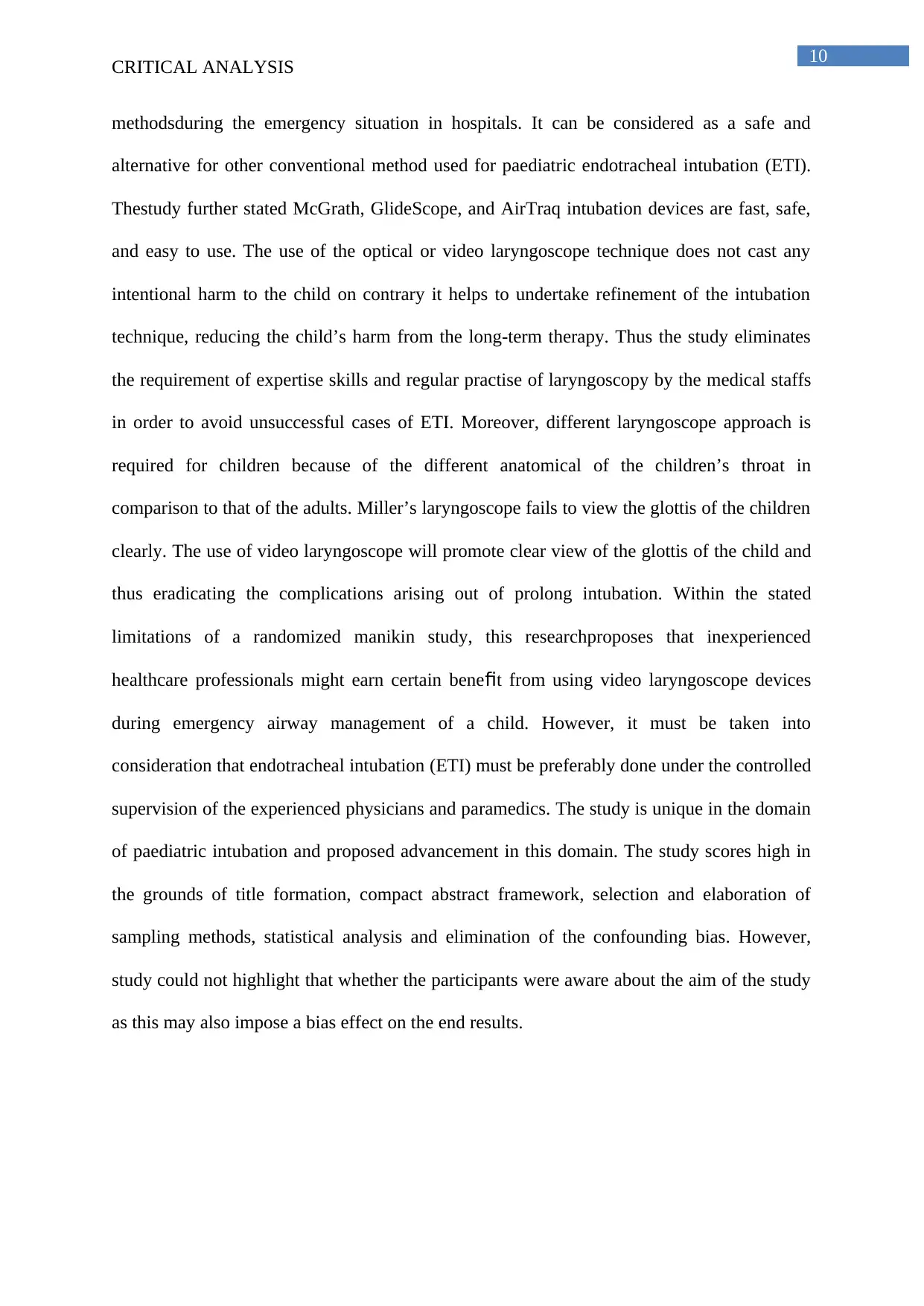
10
CRITICAL ANALYSIS
methodsduring the emergency situation in hospitals. It can be considered as a safe and
alternative for other conventional method used for paediatric endotracheal intubation (ETI).
Thestudy further stated McGrath, GlideScope, and AirTraq intubation devices are fast, safe,
and easy to use. The use of the optical or video laryngoscope technique does not cast any
intentional harm to the child on contrary it helps to undertake refinement of the intubation
technique, reducing the child’s harm from the long-term therapy. Thus the study eliminates
the requirement of expertise skills and regular practise of laryngoscopy by the medical staffs
in order to avoid unsuccessful cases of ETI. Moreover, different laryngoscope approach is
required for children because of the different anatomical of the children’s throat in
comparison to that of the adults. Miller’s laryngoscope fails to view the glottis of the children
clearly. The use of video laryngoscope will promote clear view of the glottis of the child and
thus eradicating the complications arising out of prolong intubation. Within the stated
limitations of a randomized manikin study, this researchproposes that inexperienced
healthcare professionals might earn certain benefit from using video laryngoscope devices
during emergency airway management of a child. However, it must be taken into
consideration that endotracheal intubation (ETI) must be preferably done under the controlled
supervision of the experienced physicians and paramedics. The study is unique in the domain
of paediatric intubation and proposed advancement in this domain. The study scores high in
the grounds of title formation, compact abstract framework, selection and elaboration of
sampling methods, statistical analysis and elimination of the confounding bias. However,
study could not highlight that whether the participants were aware about the aim of the study
as this may also impose a bias effect on the end results.
CRITICAL ANALYSIS
methodsduring the emergency situation in hospitals. It can be considered as a safe and
alternative for other conventional method used for paediatric endotracheal intubation (ETI).
Thestudy further stated McGrath, GlideScope, and AirTraq intubation devices are fast, safe,
and easy to use. The use of the optical or video laryngoscope technique does not cast any
intentional harm to the child on contrary it helps to undertake refinement of the intubation
technique, reducing the child’s harm from the long-term therapy. Thus the study eliminates
the requirement of expertise skills and regular practise of laryngoscopy by the medical staffs
in order to avoid unsuccessful cases of ETI. Moreover, different laryngoscope approach is
required for children because of the different anatomical of the children’s throat in
comparison to that of the adults. Miller’s laryngoscope fails to view the glottis of the children
clearly. The use of video laryngoscope will promote clear view of the glottis of the child and
thus eradicating the complications arising out of prolong intubation. Within the stated
limitations of a randomized manikin study, this researchproposes that inexperienced
healthcare professionals might earn certain benefit from using video laryngoscope devices
during emergency airway management of a child. However, it must be taken into
consideration that endotracheal intubation (ETI) must be preferably done under the controlled
supervision of the experienced physicians and paramedics. The study is unique in the domain
of paediatric intubation and proposed advancement in this domain. The study scores high in
the grounds of title formation, compact abstract framework, selection and elaboration of
sampling methods, statistical analysis and elimination of the confounding bias. However,
study could not highlight that whether the participants were aware about the aim of the study
as this may also impose a bias effect on the end results.
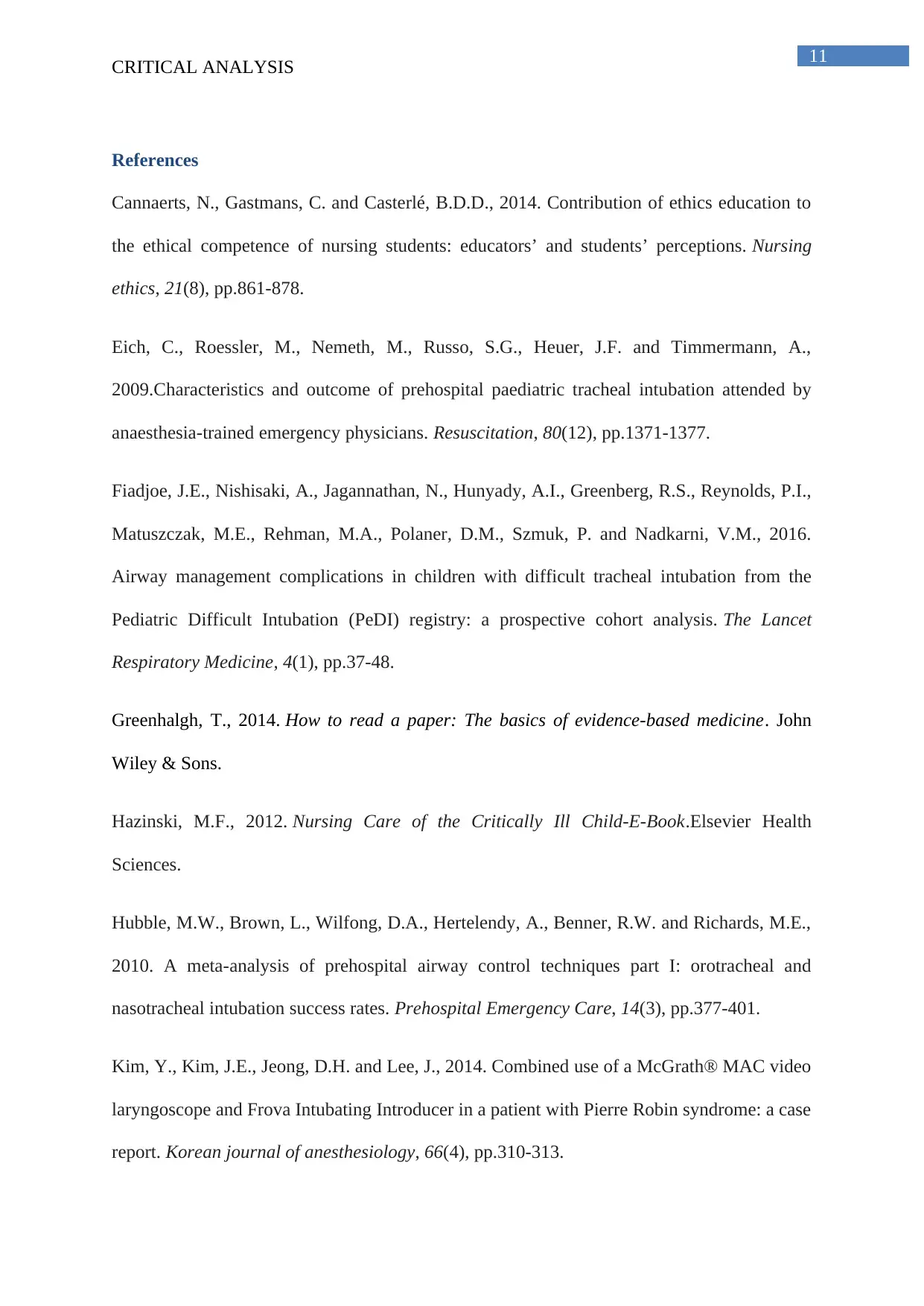
11
CRITICAL ANALYSIS
References
Cannaerts, N., Gastmans, C. and Casterlé, B.D.D., 2014. Contribution of ethics education to
the ethical competence of nursing students: educators’ and students’ perceptions. Nursing
ethics, 21(8), pp.861-878.
Eich, C., Roessler, M., Nemeth, M., Russo, S.G., Heuer, J.F. and Timmermann, A.,
2009.Characteristics and outcome of prehospital paediatric tracheal intubation attended by
anaesthesia-trained emergency physicians. Resuscitation, 80(12), pp.1371-1377.
Fiadjoe, J.E., Nishisaki, A., Jagannathan, N., Hunyady, A.I., Greenberg, R.S., Reynolds, P.I.,
Matuszczak, M.E., Rehman, M.A., Polaner, D.M., Szmuk, P. and Nadkarni, V.M., 2016.
Airway management complications in children with difficult tracheal intubation from the
Pediatric Difficult Intubation (PeDI) registry: a prospective cohort analysis. The Lancet
Respiratory Medicine, 4(1), pp.37-48.
Greenhalgh, T., 2014. How to read a paper: The basics of evidence-based medicine. John
Wiley & Sons.
Hazinski, M.F., 2012. Nursing Care of the Critically Ill Child-E-Book.Elsevier Health
Sciences.
Hubble, M.W., Brown, L., Wilfong, D.A., Hertelendy, A., Benner, R.W. and Richards, M.E.,
2010. A meta-analysis of prehospital airway control techniques part I: orotracheal and
nasotracheal intubation success rates. Prehospital Emergency Care, 14(3), pp.377-401.
Kim, Y., Kim, J.E., Jeong, D.H. and Lee, J., 2014. Combined use of a McGrath® MAC video
laryngoscope and Frova Intubating Introducer in a patient with Pierre Robin syndrome: a case
report. Korean journal of anesthesiology, 66(4), pp.310-313.
CRITICAL ANALYSIS
References
Cannaerts, N., Gastmans, C. and Casterlé, B.D.D., 2014. Contribution of ethics education to
the ethical competence of nursing students: educators’ and students’ perceptions. Nursing
ethics, 21(8), pp.861-878.
Eich, C., Roessler, M., Nemeth, M., Russo, S.G., Heuer, J.F. and Timmermann, A.,
2009.Characteristics and outcome of prehospital paediatric tracheal intubation attended by
anaesthesia-trained emergency physicians. Resuscitation, 80(12), pp.1371-1377.
Fiadjoe, J.E., Nishisaki, A., Jagannathan, N., Hunyady, A.I., Greenberg, R.S., Reynolds, P.I.,
Matuszczak, M.E., Rehman, M.A., Polaner, D.M., Szmuk, P. and Nadkarni, V.M., 2016.
Airway management complications in children with difficult tracheal intubation from the
Pediatric Difficult Intubation (PeDI) registry: a prospective cohort analysis. The Lancet
Respiratory Medicine, 4(1), pp.37-48.
Greenhalgh, T., 2014. How to read a paper: The basics of evidence-based medicine. John
Wiley & Sons.
Hazinski, M.F., 2012. Nursing Care of the Critically Ill Child-E-Book.Elsevier Health
Sciences.
Hubble, M.W., Brown, L., Wilfong, D.A., Hertelendy, A., Benner, R.W. and Richards, M.E.,
2010. A meta-analysis of prehospital airway control techniques part I: orotracheal and
nasotracheal intubation success rates. Prehospital Emergency Care, 14(3), pp.377-401.
Kim, Y., Kim, J.E., Jeong, D.H. and Lee, J., 2014. Combined use of a McGrath® MAC video
laryngoscope and Frova Intubating Introducer in a patient with Pierre Robin syndrome: a case
report. Korean journal of anesthesiology, 66(4), pp.310-313.
⊘ This is a preview!⊘
Do you want full access?
Subscribe today to unlock all pages.

Trusted by 1+ million students worldwide
1 out of 14
Your All-in-One AI-Powered Toolkit for Academic Success.
+13062052269
info@desklib.com
Available 24*7 on WhatsApp / Email
![[object Object]](/_next/static/media/star-bottom.7253800d.svg)
Unlock your academic potential
Copyright © 2020–2025 A2Z Services. All Rights Reserved. Developed and managed by ZUCOL.
